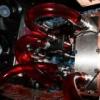Whenever you install a heatsink on a CPU
you always have to apply thermal paste....
Thermal paste is a very high heat conductive paste that is used between a CPU and heatsink to get better heat conduction. It fills in all those
microscopic imperfections on the heatsink and CPU that can trap air in them and cause a loss in the heatsink's performance. Air is a very poor conductor of heat....
However...
too much thermal paste will hinder a heatsink's ability to cool properly....
go
here ..to get the lowdown on applying the paste and/or follow the directions that came with the paste you get..
Metal based thermal paste are the most popular ....These pastes have lots of little metal particles in the grease that have a high thermal conductivity.... One disadvantage of this type of paste is that it is also electrically conductive as well so you must be careful not to get it anywhere on the mobo
or it can cause a short...Ceramic-based thermal paste are also a popular solution that doesn't perform quite as well as metal-based pastes, but the difference is minimal (1-3C). These consist of some form of thermally conductive material with lots of little ceramic particles.
The advantage of ceramic-based pastes is that they do not conduct electricity....Silicon-based thermal paste are usually what thermal pads that come on stock heatsinks are made of.... These work well also...
For brands of thermal paste the best around are...in no particular order
Arctic Silver 5.. metallic based...
there is the risk of causing a short in the electronic components..
Arctic Cooling MX-2 ...it is completely metal free.
The biggest advantage to this is the lack of conductivity ... Coollaboratory liquid pro (
you cannot use it on aluminum heatsinks )
IMHO..Others may work but maybe not as good...pay the few extra dollars that are needed for some of the more expensive brands...it is usually worth it....
some reviews on comparing the thermal pastes are
here and
hereto get extra cooling you can lap the heatsink..the lowdown is
here..lapping your heat sink can create a better surface for heat transfer. You should notice close to a 5°C drop in CPU temperature, although your results may vary....
IMPORTANT NOTE ON LAPPING...
if you don't do this properly...you can wind up with a heatsink that is not flat and be worse off than before you started...the surface you put the sanding paper on
MUST be perfectly flat ..and you must keep the heatsink flat against the paper...
When you lap your heatsink...
and you do a good job of it.. you will require even less thermal paste as these
microscopic imperfections have got even smaller...
















 Sign In
Sign In Create Account
Create Account

